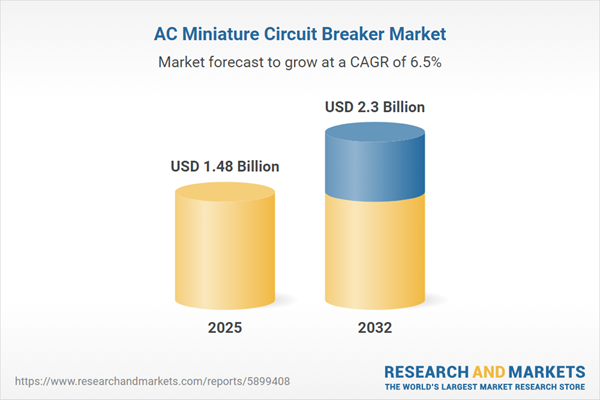Speak directly to the analyst to clarify any post sales queries you may have.
As industries continue to transform electrical infrastructures, the AC miniature circuit breaker market has become a focal point for organizations seeking operational safety, regulatory compliance, and the ability to adapt to new technology. Senior decision-makers drive change by prioritizing the integration of reliable, intelligent protection solutions that support both existing assets and future modernization projects.
Market Snapshot: AC Miniature Circuit Breaker Market Size and Growth Outlook
The global AC miniature circuit breaker market is positioned for steady growth, with the market size forecast to rise from USD 1.39 billion in 2024 to USD 1.48 billion in 2025, and projected to reach USD 2.30 billion by 2032. This positive outlook is driven by ongoing infrastructure upgrades, increasing automation in manufacturing and commercial environments, and the growing need to harmonize legacy systems with smart, connected alternatives. Modernization efforts across diverse sectors fuel demand for protection systems that can be deployed in both new and established installations. Buyers focus on regulatory compliance, enhanced electrical safety, and compatibility with intelligent monitoring platforms as they balance established system needs with advanced circuit breaker technology.
Scope & Segmentation: Defining Factors in the AC Miniature Circuit Breaker Market
Successful investment in the AC miniature circuit breaker market depends on clearly understanding evolving end-user needs, technology trends, and market segments. Key drivers influencing both product development and procurement decisions include:
- End Users: Serving commercial properties, manufacturing plants, residential buildings, and utility operators, each requires solutions meeting specific safety and standards requirements.
- Current Ratings: Solutions support a wide spectrum of load requirements, addressing daily operational cycles and the stability needed for mission-critical applications.
- Breaker Types: Available in electronic, high-intensity magnetic, and thermal magnetic variants, enabling tailored risk management and operational alignment.
- Applications: Used for lighting control, power distribution, motor protection, and solar integration, supporting both centralized grids and distributed energy infrastructure.
- Distribution Channels: Supplied through aftermarket providers, authorized distributors, and OEM partners, offering organizations flexibility and control over supply chain and asset lifecycle.
- Technologies: Combining mechanical breakers with digital monitoring and connectivity, companies leverage real-time system data for efficient management and rapid incident response.
- Trip Characteristics: Multiple trip curve options such as B, C, and D facilitate defenses against various electrical fault profiles and operating conditions.
- Pole Configurations: Single- through four-pole designs grant adaptability necessary for upgrades and expansion projects of all scales.
- Mounting Types: DIN rail and panel options allow straightforward integration into both existing facilities and new construction, streamlining deployment efforts.
Regional trends shape market priorities: The Americas and EMEA are renewal-driven, focusing on compliance with dynamic electrical codes, while Asia-Pacific and emerging markets emphasize rapid automation, solar integration, and localized adaptation of product solutions. These factors impact everything from digital monitoring adoption to region-specific customization.
Key Takeaways for Senior Decision-Makers
- Ensuring ongoing reliability and adherence to evolving regulations supports uninterrupted operations in sectors where safety and uptime are critical.
- Smart features and remote diagnostic capabilities enable organizations to adopt proactive maintenance, minimizing unexpected downtime and maximizing asset performance.
- Diversification of suppliers and expansion of distribution channels strengthen the organization's ability to adapt in times of regulatory change or supply chain disruption.
- Aligning product choices to regional technical standards and operational environments ensures compatibility and accelerates project deployment across diverse markets.
- Flexible designs simplify both first-time installation and subsequent upgrades, allowing organizations to phase modernization projects according to budget and strategic priorities.
- Robust after-sales support and lifecycle services extend system uptime and enhance the reliability of supplier relationships, contributing to long-term organizational resilience.
Tariff Impact: US Market Dynamics in 2025
Recent adjustments to US tariffs have increased pressure on sourcing costs for steel and electronic components in AC miniature circuit breakers. To address these shifts, businesses are standardizing key components, diversifying supplier networks, and adopting agile supply chain practices. These approaches help ensure operational stability and reduce financial risk in the face of changing input costs.
Methodology & Data Sources
This research utilizes in-depth secondary analysis from proprietary and open data sets, validated by specialists with experience in electrical infrastructure markets. The methodology guarantees actionable insights for strategic planning and leadership in both established and developing sectors.
Why This Report Matters
- Supplies executives with targeted strategies for addressing complex procurement and regulatory issues as the AC miniature circuit breaker industry evolves.
- Strengthens financial oversight and supply chain decision-making for organizations investing in established and high-growth markets alike.
- Guides leadership teams toward operational improvements that meet both local requirements and dynamic industry needs.
Conclusion
Strategic management and supplier collaboration are essential in this evolving market landscape. Senior leaders can use the insights provided to ensure compliance and maintain resilient operations throughout ongoing industry transformation.
Additional Product Information:
- Purchase of this report includes 1 year online access with quarterly updates.
- This report can be updated on request. Please contact our Customer Experience team using the Ask a Question widget on our website.
Table of Contents
3. Executive Summary
4. Market Overview
7. Cumulative Impact of Artificial Intelligence 2025
Companies Mentioned
The companies profiled in this AC Miniature Circuit Breaker market report include:- Schneider Electric SE
- Siemens AG
- ABB Ltd
- Eaton Corporation plc
- Legrand SA
- Hager Group GmbH & Co. KG
- Mitsubishi Electric Corporation
- Fuji Electric Co., Ltd
- General Electric Company
- CHINT Group Corporation
Table Information
| Report Attribute | Details |
|---|---|
| No. of Pages | 185 |
| Published | October 2025 |
| Forecast Period | 2025 - 2032 |
| Estimated Market Value ( USD | $ 1.48 Billion |
| Forecasted Market Value ( USD | $ 2.3 Billion |
| Compound Annual Growth Rate | 6.4% |
| Regions Covered | Global |
| No. of Companies Mentioned | 11 |









